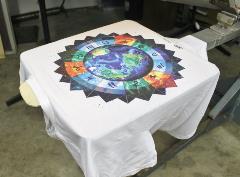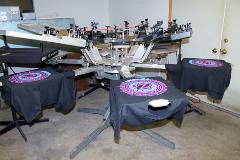 The fashion world has been decorating fabric with water-based inks and dyes for decades, and now finished-garment decorators are taking up water-based printing as well. Today’s water-based ink systems offer a full range of products for textile screen printers that can be used across a wide scope of fabrics including cotton, polyester, 50/50 and tri-blends.
The fashion world has been decorating fabric with water-based inks and dyes for decades, and now finished-garment decorators are taking up water-based printing as well. Today’s water-based ink systems offer a full range of products for textile screen printers that can be used across a wide scope of fabrics including cotton, polyester, 50/50 and tri-blends.
Water-based printing is easy, but it’s wise to review the main variables in the process before printing your first job.
Screen Emulsions
The screen emulsion needs to be water resistant to keep the stencil from breaking down during the print run. Screen emulsion chemistry has improved significantly in recent years and it is no longer necessary to use hardeners for water-based inks, even on long runs. Dual cure emulsions work extremely well with water-based inks and the mesh can still be reclaimed after use. Alan Howe from SAATI Chemical explained, “Proper complete drying of the stencil is especially true in dual cure and diazo products where water molecules prevent cross-linking, as these will be the soft spots that start breaking down on the screen.”
Squeegee Selection
Water-based printing is similar to traditional screen printing when it comes to squeegee selection: A softer squeegee will lay the ink on the surface of the garment and a harder durometer blade will drive the ink deeper into the fabric. A 60-durometer squeegee with a sharp edge is a good standard squeegee for manual or automatic water-based printing. Some printers have upgraded to a triple durometer squeegee, like a 60/90/60, where the soft 60-durometer edge lays the ink on the surface of the garment and the 90-durometer core keeps the squeegee from deflecting.

Mesh
Coarse screen meshes have historically been a common choice for printing water-based inks, but today’s systems now use much finer screen meshes. A 110 mesh is still a good choice when printing a water-based dye migration stopper or when printing high solid water base on dark garments, but many of today’s water-based inks can be printed all the way up to 305 mesh! Or, try printing with the “S” screen mesh. The thread diameter is smaller and allows for a larger percentage of open area in your screen, resulting in a noticeable difference in print opacity when compared to standard mesh.
According to Ray Smith, Field Tech Services Manager, PolyOne, “With water-based inks, the goal with mesh is to achieve the most open area possible while maintaining a clean image edge. Mesh counts between 110 and 230 are recommended for vector designs to provide good ink deposit. Higher mesh, such as 230 to 305, could be used in halftone printing if needed.”
These are just a few of the considerations when printing with water-based inks versus plastisol. Read more on additional variables in the water-based process, from artwork to on-press considerations.